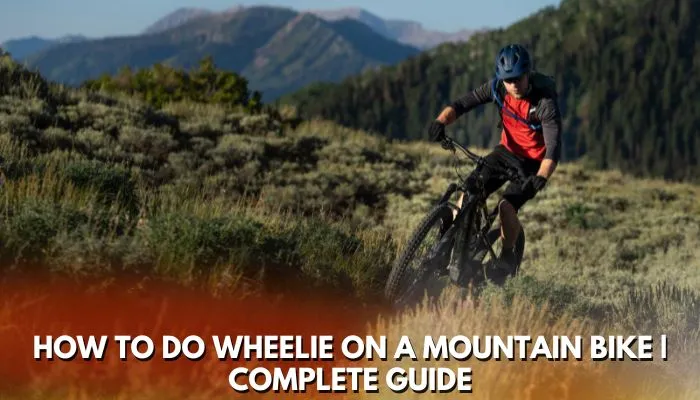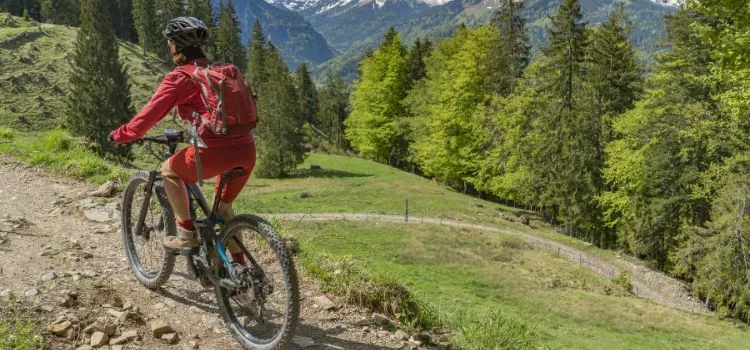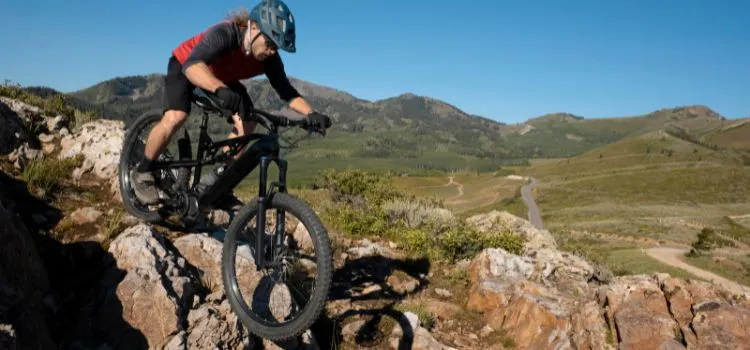How To Do Wheelie on A Mountain Bike | Complete Guide

Wheelies are entertaining to attempt and, of course, a great way to entertain your friends. Wheelies come in two different basic variations. Learning to pedal the wheelie first is necessary because it is a trick. The manual wheelie is more challenging. When you need to elevate your front wheel over impediments in your route, such as stones or tree roots, it might be beneficial on the trail.
Table of Contents
Short Answer
How To Do A Wheelie On A Mountain Bike? When you take the wheelie down to its fundamentals, learning to perform it is as simple as learning to peddle while maintaining the front wheel at the balancing point and utilizing the rear brake to prevent flying off the back of the bike.
Becoming an expert wheelie rider on a mountain bike takes a lot of practice. Every biker who can do a mountain bike wheelie began studying some tips of the mountain bike wheelie. More than simply a remarkable feat, learning to wheelie is beneficial.
It takes time and is one of the most complex moves you will ever attempt. Some World Cup riders can’t pull off a smooth wheelie without hitting the ground.
How To Do Wheelie on A Mountain Bike?
Follow these simple steps to learn How To Do a Wheelie on A Mountain Bike?
Step 1: Firstly, examine the mechanical condition of your bike. It would be preferable if you used an MTB rather than a road bike to practice on the grass area. You must Lower your saddle downshift and wear your helmet at all times. Also, you need to keep your finger on the back brake as well.
Step 2: You need to ride straight and slowly in low gear. Lean slightly forward and prepare to put all of your weight behind you. These steps determine how to wheelie a mountain bike.
Step 3: Then you need to shift back weight, hold up on the bars of MTB, and move the foot lever vigorously. The front wheel of your bike will rise above the as a result.
Step 4: You need to move the foot lever forcefully until the balance of your feet. When you reach that equilibrium, you will sense and adjust the force on your foot lever to keep up with your stance. Always place your hand on the brake at the backside. If the wheelie goes too high, you can always move back slightly by braking.
Some Tips to Enhance Quikr Your Wheelie Drive:

Here are some tips for improving your wheelie drive on a Mountain bike;
- Put on a helmet.
You have to put on a helmet when starting a ride. Therefore, it is crucial to wear a helmet when doing a stunt like a wheelie as there is a higher risk of falling than usual. Additionally, by riding your bike seriously and with care, you’ll acquire the respect of your friends and fellow riders.
- 2. Determine whatever area matches your skill
You might start your practice in a flat grassy area to prevent falls. Before starting your ride, firstly, ride through the ground to check its flatness. Otherwise, if you feel secure enough, then you need to choose a dirt or concrete path that is somewhat hilly.
- Lower the seat by adjusting it.
The wheelie of your bike requires you to sit down the whole time. So, the lower you sit for the wheelie, your center of gravity is better positioned. However, make sure you can sit securely on the saddle without falling off. Before starting the wheelie, lean back on the bike seat while elevating the front wheel to test it.
- Take out in low-to-medium gear.
When you start to wheelie a mountain bike, you must put your bike in low-to-medium gear. This is a speed that is slightly faster compared to walking. It will be challenging to pedal vigorously enough to lift the front wheel if you begin in a gear that is either too high or too low. Once you find the appropriate speed for your abilities and the area, then you can shift the gears higher or lower.
- Set the wheel position.
You also need to set the position of the crank before starting. You have to put the lever in the eleven and five o’clock spots. This allows you to put greater energy into the pedal. With your strongest leg, which should be the limb you typically start pedaling with when you stand still, you should begin the initial thrust at 11 o’clock.
- Adjust your weight.
While wheelie, you need to put more weight in the front. You need to keep sitting while curving your arms and crouching with the above part of the body over the bike’s head. You need to move your body forward toward the front initially. In this way, you create greater force, and this energy helps you to move back sharply.
- Pull back your back wheel.
Then you must pull back over the back wheel immediately. You must apply a powerful pedal stroke to execute it swiftly and simultaneously.
- Maintain sideways and vertical balance.
You must maintain vertical and sideways equilibrium simultaneously while wheelieing the bike. To change the vertical balance, you have to lower the front wheel or elevate the front wheel. Spread your arms or legs wide or bend the handlebars in the opposite direction from where the bike pulls back.
On a Bicycle, How Do You Wheelie A Pedal?

Most bicycle-riding children are skilled wheelies. Some adults secretly feel inferior if they are unable to wheelie. Some individuals will grasp how to wheelie a mountain bike in less than ten hours. Others can need days or perhaps an eternity to do their first successful wheelie.
You must try to learn a wheelie. You must know about falling while learning to wheelie a mountain bike. Balance is also an important factor in a wheelie. Look after the anxiety inside you first and foremost. While riding, individuals break bones. The worst that can happen from a wheelie is a bruise or small cut.
Don’t forget to cover the rear brake. This will help you when you face obstacles on returning to the ground on front wheels. Some experts didn’t take longer sessions, and they advised learning how to wheelie on a mountain bike for 30 minutes daily.
Firstly, you think you have accomplished nothing, but you achieve success. You’ll eventually get a hack at it if you’re pedaling in low gears with your finger on the back brake.
How Can a Mountain Bike Pop a Wheelie?
When you lift the front wheel of the bike, we can say that we pop a wheelie. It is necessary for your protection to wear a helmet, gloves, and padding. Additionally, you’ll be more confident when you pop a wheelie on a mountain bike.
Your balance should be better, and your center of gravity should be lower when you lower your seat. The upper body may move back and forth quickly and provide flexibility when the seat lowers.
When you start to wheelie a mountain bike, your power pedal should be at roughly 2 o’clock. Nevertheless, you have to pull the handlebars up and your upper body backward to set the pedal at 5 o’clock. To hold a wheelie for a more extended period, you have to keep elevating the front until you find the ideal point of balance.
FAQs
How can you get better at wheelies?
If you don’t have a wheelie bike, firstly you have to buy a bike. Making friends who are experts in wheelies and with those who like to ride. Try to practice off-road. You must follow the step given above to refine your wheelie skills.
Does a wheelie cause harm to your bike?
If you wheelie your bike correctly, then it won’t harm your bike. But if you perform wheelie incorrectly, your bike will suffer severe damage. This makes it necessary to practice preventing damage to your bike. Otherwise, when your bike topples over during a bad wheelie, you risk your bike by damaging your chain or rear mech.
Conclusion
Riding a mountain bike is enjoyable. Learning some tips and stunts can make riding a bike more exciting. The first one is a wheelie, which you can learn fast.
A mountain bike is appropriate for cycling on any surface and uphill. So, if you are thinking about how to wheelie a mountain bike, always keep in mind safety. Here we’ve explained the tips and tricks regarding the wheelie of a mountain bike. Now you can learn how to wheelie a mountain bike by reading this article.
